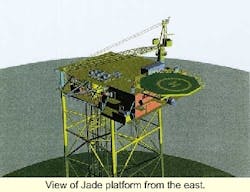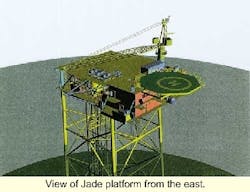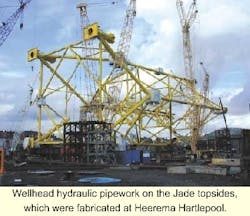HP/HT TECHNOLOGY: Unmanned Jade development, pipeline tackling HP/HT conditions
Nick Terdre
Contributing Editor
Production on Phillips Petroleum's Jade Field in the UK North Sea will begin in October. The project, the first satellite development to make use of the Judy infrastructure, has presented a series of challenges, mainly connected to the field's high-pressure/high-temperature (HP/HT) reservoir.
Jade is being developed with a minimum facilities, normally unattended, wellhead platform, to be installed in May. Starting in June, the wells will be drilled by a jackup rig cantilevered over the platform. Production, initially from one well, will be transported through a 17.3-km multiphase pipeline to Judy, from which Jade will be remotely controlled and where processing will take place.
Peak production of some 200,000 MMcf/d of gas and 15,000 b/d of condensate will be reached in 2005 and sustained for about three years. However, there is exploration potential in the area, and there are spare well slots on the platform for exploiting any commercial finds.
Such further developments could also help to prolong Jade's producing life, which otherwise is put at 15 years. According to Phillips, the field contains estimated reserves of 380 bcf of gas and 30 million bbl of condensate.
Moving to production
The licensees - Phillips (32.5%), Agip (7%), BG (35%), OMV (5.57%), and Texaco (19.93%) - have wasted little time in bringing Jade on stream. The field was discovered in March 1996 by exploration well 30/2c-3, which was suspended untested, and appraised the following year by 30/2c-4, also suspended after testing an aggregate 91 MMcf/d gas and 9,700 b/d of condensate. In anticipation of a positive result, the well was drilled through a nine-slot space frame which will also be used for development drilling.
The project took longer than expected to come up for official sanction as the Jade partners differ from those on Judy. Even though the Judy partners - Phillips, Agip, and BG - are all also Jade licensees, the involvement of two licenses meant that it took 18 months to negotiate commercial arrangements for using the Judy facilities. Government go-ahead was given in January 2000.
In late March 2001, the project was proceeding on schedule and within budget, despite a hitch in equipment supply causing a two-week delay in jacket delivery.
Jade has the necessary qualifications for membership in the HP/HT club - the reservoir is located in the Joanne formation of the Pre-Cretaceous at a depth of more than 14,000 ft. The bottomhole pressure exceeds 12,000 psi and temperature is 195° C. Experience in developing and producing from HP/HT reservoirs is limited in the UK. Four other fields preceded Jade into development - Erskine, Elgin, Franklin, and Shearwater - but so far, only Erskine has production experience. Elgin is now onstream.
Technical advances
That experience was directly available to the project as Texaco, the Erskine operator, is also part of the Jade group. One of the Erskine offshore installation managers was seconded to the design team for the front-end engineering design phase. But Jade also reflects technological advances made since Erskine was developed. All the topside piping is fully pressure-rated, which was not feasible when Erskine was being designed. Jade provides regular accommodation facilities rather than the temporary refuge installed on Erskine.
After the engineering, procurement, and construction phase got underway, Phillips increased the wellhead shut-in pressure from 10,000 psi to 11,000 psi. The move was not lightly undertaken, according to project manager Charlie Shepherd. It meant all topside piping, valves, and chemical injection equipment had to be upgraded, but it provided a greater margin of assurance that the facilities could cope with the reservoir challenges with something to spare.
Thermal expansion is one of the big headaches posed by high temperature reservoirs. After topside construction began, in light of experience from Shearwater, some of the pipework in the wellhead was moved to allow more room for thermal expansion of the well tubulars.
The multiphase export pipeline proved to be a source of headaches, or more bluntly, a "nightmare." Phillips had settled on a pipe-in-pipe concept, allied with chemical injection, to ensure flow assurance. It intended to use a snake-lay installation method to allow for the linear expansion of the pipeline, once filled with hot well fluids. Over 17 km, the line could expand by up to 16 meters. Just 14 days after Phillips signed the pipelay contract with EMC, a rupture was reported on the Erskine pipe-in-pipe export line.
Expansion challenge
In the wake of this failure, a very rigorous review of the Jade pipeline requirements was carried out, Shepherd says. However, the snake-lay concept Phillips intended to use was different from that employed on Erskine. In particular, a different method of making the field joints, using half-shells rather than over-lapping sleeves, was chosen. But Phillips' concept was untested, and with the extra care that was being taken following the Erskine pipeline failure, the company found itself in a race against time to get the concept qualified.
Eventually, the race was lost, and the company had to turn to a tried and tested method to preserve the schedule. But the potential benefits of the snake-lay concept are significant, and the company would consider it for future projects, Shepherd says.
Instead of snake-lay, the pipeline will be laid straight, but with eight expansion loops installed at about 1-km intervals along its length. Each loop will replace a 28-meter length of pipeline with a stepout of 40 meters. While the main pipeline sections will be buried, the loops will be free to expand. Each side of each loop can expand about 1.6 meters. The bends and curves have been made easy so an intelligent pig can run through the pipeline.
A further problem arose late in the day when the brittleness of the bulkheads - large steel forgings installed either side of bends in the riser and initial pipeline section up to the subsea emergency shutdown valve (ESV) to stop movement between the inner and outer pipe - proved to be out of spec. The bulkheads were supplied by Welding Units, whose products are regularly used by Phillips, and which had acquired the forgings from an Italian supplier.
As the original supplier could not provide replacements in time, they have now been supplied by Newcastle-based Formet. The cost of the hitch is not large, but a two-week delay in jacket delivery has been incurred, and installation of the riser on the jacket will only take place once the jacket has been loaded onto the transport barge.
Fabrication
The jacket was fabricated at Kværner's Methil yard under a £9.1 million design, procure, and construct) contract. Although Phillips originally specified a conventional square base, it accepted Kværner's proposal to use a twisted base. In this configuration, the base square is aligned at a 45-degree angle to the vertical tower section.
The design, which was used for the wellhead platforms in the Erskine, Shearwater, Elgin, and Franklin HP/HT developments, provides a larger footprint, which reduces pile loads and allows easier access for the drilling rig. The jackup can approach within three meters of the wellbay vertical face, without any interference from the pile on this side, which is located below the mid-point of the platform side and away from the spud-cans on either side. The twisted-base design is a patented Kværner concept, though this is the first time the company itself has built such a structure.
The jacket is 99.6 meters high and measures 28 meters by 28 meters at the top, and 39.6 meters by 39.6 meters at the base. It has a lift weight of 2,600 tons and will be held in place by just four piles, each of which is 63.5 meters long and 2.4 meters in diameter and weighs 250 tons. Tubulars, including piles, were fabricated by Sif in Holland and EEW in Germany.
The jacket was fabricated at Kværner's Methil yard under a £9.1 million design, procure, and construct) contract. Although Phillips originally specified a conventional square base, it accepted Kværner's proposal to use a twisted base. In this configuration, the base square is aligned at a 45-degree angle to the vertical tower section.
Despite the extra costs involved in implementing design changes, savings in other areas have helped keep the overall cost to the budgeted level. The topsides, constructed by Heerema Hartle-pool, have a lift weight of 2,000 tons and a gross operating weight of 4,700 tons.
Subsea valving
The wellbay has 12 slots, of which five are currently designated for Jade. On arriving at the topsides, the wellstream passes through a choke downstream of each tree, a high-integrity pressure protection system (HIPPS) consisting of two valves in series, past a multiphase meter, through an isolation valve, and thence to the manifold where the various streams are brought together. The single stream then passes through a couple of manually operated isolation valves, through the topsides ESV, and into the riser.
The section from the topsides ESV, through the riser, and along the initial 200 meters of pipeline to the subsea ESV has a design pressure of 415 bar, while the main section of the pipeline is rated to 150 bar. This will ensure that in the event of an excessive increase in pressure and failure of the HIPPS system, any rupture of the pipeline will take place at some distance from the platform, thus minimizing the risk to human life and the topside facilities.
The solution, adopted by Phillips, was not a requirement set by the Health & Safety Executive, Shepherd said. A subsea isolation valve is also installed at the Judy end of the pipeline.
Chemical injection, including methanol, will be used to inhibit wax and scale formation and corrosion of the pipe walls. The main section of the pipeline uses carbon steel, but the riser and initial 200-meter section of the pipeline are internally clad to provide protection against cooling of the fluids or failure of the inhibitors to mix evenly in the fluids. The topsides piping is made from duplex and other high-performance steels.
Special modules
The platform has no flare system. In the case of over-pressure, gas will be cold vented. A blast wall separates the wellhead area from the utilities area, and the accommodation unit also has a blast/fire wall. As there is regular accommodation, both a fire-pump and lifeboat have been installed.
Accommodation for 12 persons is provided, although for emergency purposes, up to 20 can sleep overnight if needed. Maintenance visits are planned at 60-day intervals to replenish fuel and other consumables. Well intervention is also expected to be needed. For wireline operations, the 36-ton pedestal crane will be used. Brown & Root was awarded a five-year maintenance services agreement.
Although the Jade platform will be controlled from Judy, initial startup will be carried out from the platform's own control room, where a dual control system supplied by ABB is installed. Should the platform need to be shut down, a restart will also have to be carried out from on board. However, if the platform is shut down because of a shutdown of functions on Judy, it will be possible to restart Jade operations from Judy.
One of Judy's two separator trains will be dedicated to handling the Jade well fluids, and fiscal monitoring will be carried out on this platform. Judy will shut down in the second half of May for the tie-in work.
Safety performance on the project has been very good so far, according to Shepherd. At the Heerema Hartlepool yard, where some 350,000-400,000 work-hours have been performed, there have been no lost-time accidents, and only two at Methil, where a total of some 200,000 hours has been worked.
The platform will be installed in the second half of May by Saipem's S7000 crane-barge. Two docking piles have been installed on one of the existing wells to guide the jacket into place. Heerema is responsible for offshore hookup.
The pipeline installation will take place from early April to early June. The main section of the line will be installed by EMC using the Castoro 6 pipelay barge. Dummy spools will be laid where the expansion loops are to go.
The loops will then be installed by Halliburton Subsea - each will be in two parts, which will be flanged together at the top. Of the pipeline cost of £32.5 million, EMC's contract is worth £20 million, £7 million over the sum originally agreed due to the changed scope of work.
Drilling will be carried out by Santa Fe Drilling's Galaxy 1 jackup, a rig Phillips has used on various occasions in the Judy area and which earlier this year was drilling an exploration well through the Judy platform. The rig's first task will be to extend and recomplete the 30/2c-4 appraisal as a producer. Startup will be based on this well. A further three producers will then be drilled in a program that is expected to last until August 2002. The discovery well, 30/2c-3, which missed the crest of the reservoir, will be used for drill cuttings injection.
Each well is expected to have a productivity of up to 75 MMcf/d, but will normally be required to deliver 50-60 MMcf/d. If one of the wells does not come in as planned, the drilling contract has an option for a fifth producer.



